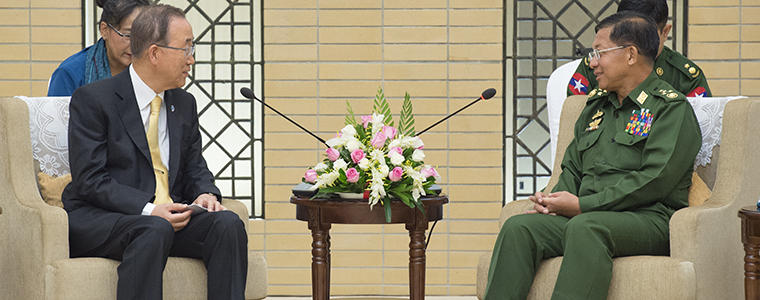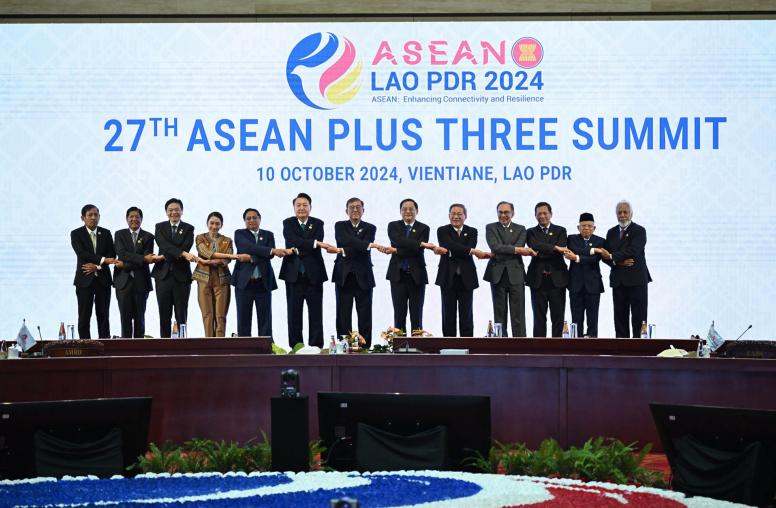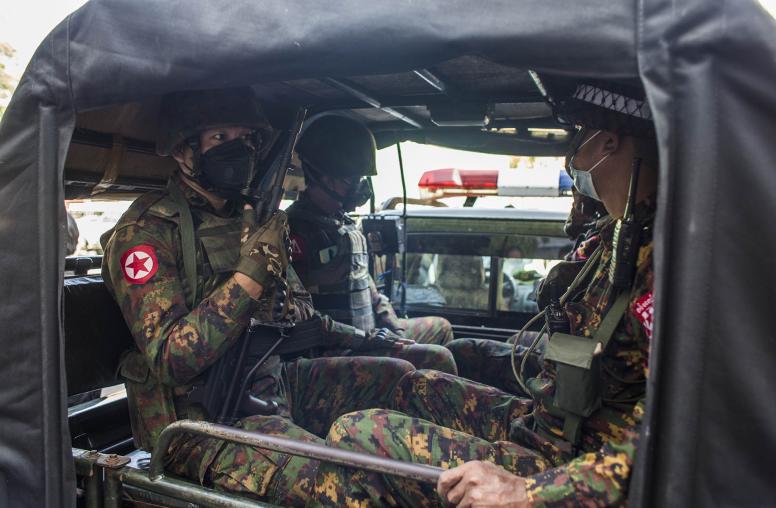Myanmar Peace Process: Slow Progress, Delicate Steps
Cooperation of New Government, Military Seen as Key to Ending Conflict
The peace process in Myanmar, which seeks to end decades of conflicts between the country’s army and an array of rebel groups, is progressing fitfully but could still face a reversal, experts on the Southeast Asian nation said in a discussion at the U.S. Institute of Peace. To drive it forward will require that the country’s new democratic leadership to skillfully manage relations with the still-powerful military while pushing negotiations and building confidence with the nation’s diverse armed movements.

As Myanmar continues its transition to democracy after 50 years of military rule, its defining challenge now is to make peace, said Derek Mitchell, the former U.S. ambassador to Myanmar and now a senior adviser at USIP. Armed ethnic groups have been engaged in conflict since even before independence from the U.K. in 1948. They are fighting for autonomy, independence or ethnic minority rights, and also sometimes motivated by economic incentives. Only recently have “rays of hope” appeared for an end to violence, said Ambassador U Aung Lynn in opening remarks.
“There’s a lot at stake in this.” – Former U.S. Ambassador to Myanmar and USIP Senior Advisor Derek Mitchell
“This is not just the longest running civil conflict in the world but probably the most complex,” said Mitchell, who became the first U.S. ambassador to the country in 24 years, after diplomatic relations were upgraded in 2012. “The result is the most complicated peace process we’ve found anywhere. Trying to corral all these groups—18, 20 of them — with their different interests and identities into a single unified peace approach is extraordinarily difficult.”
In its first eight months, the elected government of State Counsellor Aung San Suu Kyi and her National League for Democracy party (NLD) has made the peace process its top priority and invited more of the country’s ethnic armed groups to join new talks. Still, fighting has continued and in some places grown considerably worse, said David Mathieson, a Rangoon-based researcher for Human Rights Watch, signaling the challenges ahead to creating political stability and economic development.
A conference Aug. 31 to Sept. 3 that relaunched Myanmar’s peace process almost a year after some of the country’s armed groups signed a nationwide ceasefire agreement was a positive development, said Ambassador Vijay Nambiar, the United Nations Special Adviser to the Secretary-General on Myanmar. It showed the NLD leadership is committed to national reconciliation through political dialogue, he said. A schedule for negotiations is on track, contributing further to its credibility, he said. Although only eight armed groups ultimately signed onto the nationwide ceasefire agreement, Suu Kyi is pushing to get all the ethnic armed elements on same peace process track, Nambiar said. Most of them, he added, want to join the talks even if they declined so far to join the ceasefire.
At this point, “the army, the groups and the government know there is no military solution,” he said. Even so, the peace process “hasn’t reached the stage that it’s irreversible,” he added.
The Military’s Role
The key challenge for the NLD is solidifying cooperative relations with the military Nambiar said. The generals have made clear that unless they’re convinced the NLD can manage the peace process and produce reasonable stability in the restive regions, they’re unlikely to give up control of the security ministries and 25 percent of the seats in parliament reserved for them, he said.
The army’s primary definition of progress is to see the armed groups beginning to disarm and demobilize. Yet given their lack of trust in the military or confidence in the government, it’s not a goal likely to be achieved at an early stage in the process, Nambiar said. As broad agreement emerges on maintaining a united federal state, the armed groups’ are talking about integrating into the national army, among many options. The peace process will only advance if the military doesn’t push too hard on demobilization, Nambiar concluded.
The most important step for the peace process this year was the 21st Century Panglong Conference, or Union Peace Conference, held in September, said Vanessa Johanson, USIP’s country director in Myanmar. Its historical backdrop is the 1947 Panglong Conference led by Suu Kyi’s father, General Aung San.
The sessions brought together the army and government with the widest array yet of armed groups, both those that signed the nationwide ceasefire agreement of 2015 and those that hadn’t, she said. But the conference, scheduled to convene every six months, resulted in no decisions, and the government had resolved previously that joining the 2015 ceasefire accord would be a prerequisite for participating in the national dialogue.
“So, we are back to asking how to negotiate a ceasefire with groups that didn’t sign,” Johanson said. Among them are the largest ethnic armed groups, including the United Wa State Army; and some that have been in ongoing conflict with the Myanmar Army in recent years including the Kachin Independence Army, the Ta’ang National Liberation Army, Arakan Army and the Myanmar National Democratic Alliance Army.
Steps for Dialogue
A few weeks ago, the government released a new framework for political dialogue with timetables and interim steps for tackling economic, social, security and political issues. That should help push it along, Johanson said.
Still, she said, numerous concerns hover over the peace process:
- New fighting concentrated in Kachin and Northern Shan states—perhaps as the military seeks to pressure non-signing groups to join the ceasefire agreement—makes negotiating ceasefires with all groups more difficult and erodes trust among the current participants.
- The political and security aspects of the nationwide ceasefire are yet to be implemented after a year, most crucially on-the-ground monitoring.
- The government’s reconfigured National Reconciliation and Peace Center is too small and lacks sufficient autonomy to handle peace negotiations, though some of the staff are very skilled, experience and committed.
- Negotiating volatile issues in detail in the political dialogue such as natural-resource sharing and the future of the ethnic armies is dauntingly complex.
- The peace process includes too narrow a representation and needs the addition of women, civilian ethnic leaders and civil society in ceasefire monitoring.
“There’s a lot of hope in the process but most of the major challenges lie ahead,” Johanson said.
In the meantime, fighting has picked up in many parts of Myanmar against groups that didn’t join the agreement, according to Mathieson, who joined the discussion by phone from Rangoon. Besides the “dire” effects on civilians, the violence, including stepped up air strikes and a threatened offensive against the Kachin Independence Army, is thwarting movement on the peace process, he said.
While Mathieson said there’s reason to fear erosion of the peace process, research on the ground has shown one clearly positive development: civil society, nurtured by the international community, along with new members of parliament, are playing a growing role in conflict mediation and mapping. They also are helping intervene with various armed groups, particularly to deal with abductions or abuse.
“They are improving the situation,” Mathieson said.
The international community will need patience and understanding to bear with Myanmar’s complex peace process, Mitchell said. There’s little choice for anyone involved with the country, he added.
“There’s a lot at stake in this,” Mitchell said. “If they don’t get this right, then not much in the country is going to go right, including democracy.”



